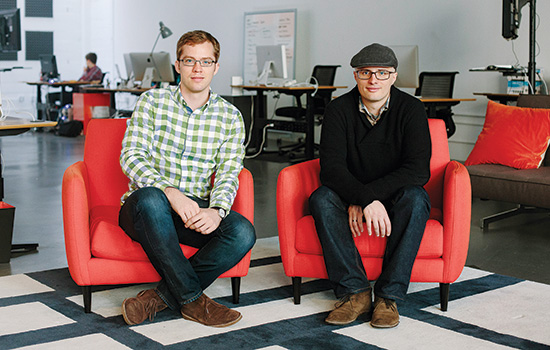Grads solve problem, create business
Chris Zacharias ’04 (new media/information technology), left, and Jeremy Larkin ’01 (new media) founded Imgix, a service that makes images look better on the Web.
You can surf the Web on a desktop computer. Or a laptop, smartphone or tablet. No matter what device you use, or what brand, you expect the pictures to look good.
That is no easy task, but a San Francisco company started by two RIT graduates intends to “make the Internet better by providing smarter, faster images.” Imgix (Imgix.com) is a service that instantly sizes, crops and formats images from customers’ websites, optimizing the images for viewing on a variety of devices.
As traffic to a website grows, said CEO and co-founder Chris Zacharias ’04 (new media/information technology), companies face the problem of making images available on many platforms simultaneously. Imgix allows customers to cache their entire image archive and manipulate size, cropping and other functions with no speed loss to users.
“We were trying to solve a problem that had plagued us personally,” said Jeremy Larkin ’01 (new media), co-founder and CTO. “We wanted to make more beautiful images available on the Web. The technology for imaging (on the Web) was stuck in the ’90s. We wanted to figure out how to create new technology, push the boundaries.”
“Everyone is looking to solve this problem,” added Zacharias, a Rochester native. “The way the Web is moving, all the sites are heavily image-focused. At the same time, the big thing that has changed is the growth of mobile and personal devices, all different sizes, configurations. Apple Retina, Android, Nooks, Kindle . . . It’s kind of going insane.”
Imgix took root in 2011, a year after Zacharias left an enviable position as senior Web developer at Google/YouTube.
Leaving was not an easy decision. For starters, “Google is absolutely the best place in the world to work and they do pay very well.” In three years at the company, he had been very successful. Among other projects, Zacharias conceived of, built, and launched YouTube Feather, a light version of the website that allows it to load quickly in parts of the world with slow Internet connections.
He didn’t have another job lined up; in fact, he wasn’t quite sure what he would do. However, “Given my plans for my life, I realized there was only a small window where I could reasonably afford to take big risks,” Zacharias wrote in a blog post (blog.chriszacharias.com/cruise-ships).
At the suggestion of a friend, Zacharias wrote a business proposal that was accepted into a three-month program at Y Combinator, a Silicon Valley business accelerator that provides seed money, advice and connections for promising startups.
Larkin, a native of Colorado, had worked for several companies in the Rochester area, including Logical Solutions and Xerox, before co-founding Form Collective Ltd. in 2006. That company provided Web and mobile application development and also did consulting work for clients including Wegmans, Bausch & Lomb, Carestream, Kodak and Cornell University.
“I was looking for the next thing to do when Chris got in touch with me.” Larkin moved to San Francisco to team up with his friend in 2012.
They’ve taken on a huge opportunity and a big challenge, both say. “There is sizeable content that has to be moved quickly all over the world,” Larkin noted.
Imgix, which obtained venture capital funding last year, now has eight employees, including Miguel Cardona ’04, ’13 (new media design, industrial design), lead designer. They are hiring, but cautiously.
“For me,” Larkin said, “the big motivator is having self-direction over what I’m doing. It’s rewarding to be able to bring something new—and very much needed—onto the Internet.”















